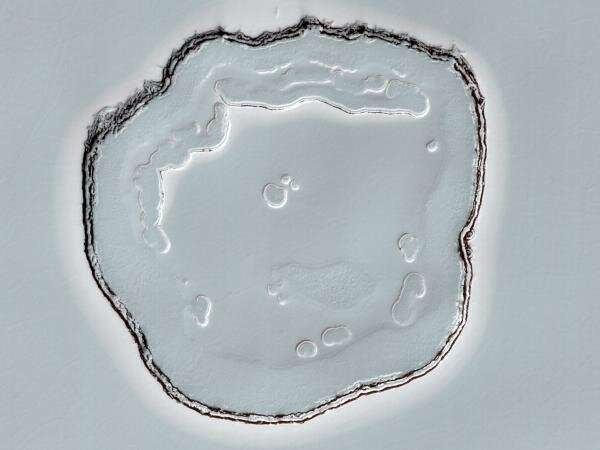This article has been reviewed according to Science X's editorial process and policies. Editors have highlighted the following attributes while ensuring the content's credibility:
fact-checked
peer-reviewed publication
trusted source
proofread
Layering history shows how water and carbon dioxide have moved across Mars

Mars' south polar layered deposits of H2O and CO2 ice record its climate history. A new study links the long-term global movement of Mars' water from midlatitude to pole to a function of the planet's orbital configuration with H2O ice deposition decreasing as a factor of obliquity, or spin-axis tilt.
"No deposit yet analyzed provides a global water cycle record that can be tied to a specific orbital history. Here, I fill this gap by analyzing H2O ice layer formation in Mars' south polar massive CO2 ice deposit, a 510,000-year climate record," said Peter B. Buhler, a Research Scientist at the Planetary Science Institute and lead author of the paper "A 510,000-year Record of Mars' Climate" that appears in Geophysical Research Letters.
"Previously, only deposition rates averaged over millions of years—which is about ten times longer than Mars' orbit cycles—had been derived," he said.
"Mars experiences 100,000-year cycles in which its poles vary from tilting more toward or away from the sun. These variations cause the amount of sunlight shining on each latitude band, and thus the temperature of each band, to cycle, too. Water ice moves from warmer to colder regions during these cycles, driving Mars' basic long-term global water cycle," Buhler said. "Up until now, the quantitative rate at which water moves through this cycle has been highly uncertain. This study addresses this open question by deciphering the layered ice record in Mars' south polar cap.

"This layering is important because it is a direct record of how water and carbon dioxide have moved around on Mars. The water layer thicknesses tell us how much water vapor has been in Mars' atmosphere and how that water vapor has moved around the globe. The carbon dioxide layers tell us the history of how much of the atmosphere froze onto the ground, and thus how thick or thin Mars' atmosphere was in the past," Buhler said.
"The history of Mars' atmospheric pressure and availability of water are critical information for understanding the basic workings of Mars' climate and near-surface geologic, chemical, and perhaps even biologic history. Specifically, the results of this work provide a major step forward for deciphering the basic workings of Mars' water cycle and, by extension, the long-term availability of near-surface water ice or even liquid brines. The availability of near surface water sources is critical for enabling near-surface life as we know it."
More information: P. B. Buhler, A 510,000‐Year Record of Mars' Climate, Geophysical Research Letters (2023). DOI: 10.1029/2022GL101752
Journal information: Geophysical Research Letters
Provided by Planetary Science Institute





















